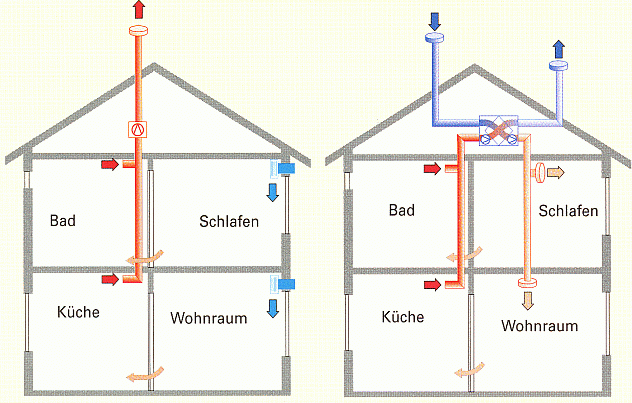Ventilating the right way
What will you find here? |

|
Fresh air is essential to personal comfort.
Heating provides us with the comfort of having the right temperature in our environment. At the same time, ventilation is essential for the removal of undesirable gases, such as carbon dioxide (contained in the air we breathe out), or radon (rising from the ground on which the house is built), as well as other nitrous oxides (released when materials such as wood, gas, oil or tobacco are burned). Are you aware, for example, that smoking pollutes the air in your environment up to a factor of 26? (Prof. Wolff, TH Wolfenbüttel)Breathing alone results in the release of 60...300g of water to the environment. Personal hygiene (2600g/h - 216g all 5 minutes!) and washing clothes (200g/h) also add a great deal of humidity to the domestic environment, creating condensation (and possibly mould!) on contact with cold walls.
[ Contents ]
Natural ventilation
Who hasn't felt wind blowing through open windows or gaps and cracks in various parts of the house? These draughts are generally known as 'natural ventilation' (or, in terms of heating technology, loss of transmission heat). On cold days, when the heating is running, we try to reduce ventilation times to a minimum, but are glad of every breath of wind on hot days.So how much ventilation do we really need?
How does the pressure of the wind impact a house?
A house can be regarded as an obstacle in the landscape, offering resistance to the wind. The wind impacts one side of the house, thus creating overpressure at the side exposed to the wind (windward), and at the same time, underpressure at the side away from the wind (leeward).'This pressure difference sucks the warmth out of the house,' says the person who has to foot the heating bill. "We need ventilation to feel good," says the fresh air fanatic, opening another window.
Below you can see a diagram showing the situation of wind pressure

[Source: Wuppertal Institut für Klima,Umwelt,Ernergie/Planungsbüro Schmitz, Aachen]
The picture on the left shows where storm wind will lift roof tiles: the underpressure area (-) on the leeward side.
[ Contents ]
Wind Speed and Direction
Look above for details about the pressure situation in and around the house, which determines what is calculated as transmission heat requirement in the heat requirement calculation. This is subject to considerable local variation.Particularly important factors in terms of heating are the wind speed and direction in winter. This is exactly what the statistics for heating energy characteristic value in Germany show.
Plotting the annual curves shows that means wind speed...
- is higher in winter than in summer everywhere in Germany.
- is greater near the coast than in inland.
- is especially low in southern Germany - (which has led windmill builders to construct giant blades).
In meteorological tables, the frequency of wind flow in a given direction around the 8 point compass-diagram is shown as a percentage:
| Frequency of winds over 5 m/s in winter as percentage | |||||||||
|---|---|---|---|---|---|---|---|---|---|
| Location | Total annual % | N | NE | E | SE | S | SW | W | NW |
| Kiel | 32.6 | 5.5 | 5.2 | 5.2 | 4.9 | 16.3 | 28.8 | 26.7 | 7.4 |
| Hamburg | 27.2 | 2.6 | 3.3 | 8.1 | 7.0 | 8.1 | 37.1 | 25.0 | 8.8 |
| Aachen | * 35.7 | 1.7 | 5.0 | 3.9 | 2.5 | 11.9 | 45.7 | 22.1 | 6.2 |
| Berlin | 24.4 | 1.6 | 3.3 | 12.3 | 7.0 | 4.5 | 15.2 | 38.1 | 18.3 |
| Leipzig | 12.4 | 2.6 | 9.7 | 7.0 | 1.8 | 14.0 | 35.1 | 21.9 | 7.9 |
| München | 12.8 | 0.8 | 7.0 | 7.0 | 0.8 | 0.8 | 47.7 | 32.8 | 3.1 |
[Source: Taschenbuch Heizung + Klimatechnik]
* The interesting thing that the table shows is that winds over 5m/s are more frequent in Aachen then in coastal towns!
[ Contents ]
Mechanical Ventilation
- The simplest way to ventilate mechanically is to use a blower for used air which allows unheated fresh air to enter freely (picture on the left).
- The more sophisticated way of ventilating is to use a cross heat-exchanger, able to recover approx. 50% of the heat from the used air (picture on the right).
- The intelligent way of ventilating is to use the technique just outlined combined with the use of the heat capacity of the earth. In this scenario, outside air is conducted through an earth heat exchanger. All you have to to is run the pipe conducting the outside air under the earth around the house (needs to be at a depth of about 1m) with the suction opening overground.
Unfortunately, systems including underground suction, such as gravel bed filters, might transport radon through the house. Not for volcanic regions!

[Source: Wuppertal Institut für Klima,Umwelt,Ernergie/Planungsbüro Schmitz, Aachen]
When there is wind, the output of an off-gas fan installed on the windward side will be smaller (greater on the leeward side) because of the greater counter-pressure. Axial fans might then be able to reach an output of zero :-(
According to the NOWA study in relation to energy efficiency ventilation systems with waste heat recovery (page 150):
'To be able to save primary energy when operating ventilation systems, in addition to the technical requirements (optimized system design with minimized air-flow related energy consumption and with waste heat recovery of high efficency) conditions for keeping exchange of air through gaps and windows have to be maintained (air-tight building design and acceptance by the users).'After many years of experimentation, the recommendation in Sweden is now to run houses with an air-exchange rate of 0.3, whitch is regarded as optimum.
A 0.1 change in the air-exchange rate results in change in specific ventilation heating requirement of 6...9kWh/(m²*a), i.e. nearly one liter of oil/(m²*a)! (Prof. D. Wolff)
[ Contents ]
Air rate
The air rate is a measure of the frequency at which the volume of air in a room is completely changed.Here are some figures for the hourly exchange of air for a range of different types of rooms:
| Type of room | Air rate/h |
| Domestic rooms in Sweden | 0.3 fold |
| Office rooms | 3...6 fold |
| Bars | 5...10 fold |
| Canteens | 6...8 fold |
| Non-smoking cinemas and theatres | 4...6 fold |
| Cinemas and theatres with smoking permitted | 5...8 fold |
| Indoor swimming pools | 3...4 fold |
| Conference rooms | 6...8 fold |
| Toilets | 4...6 fold |
| Warehouses | 4...6 fold |
[Source: Taschenbuch Heizung + Klimatechnik]